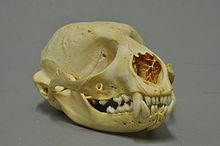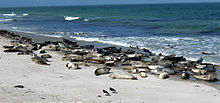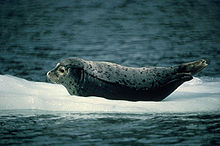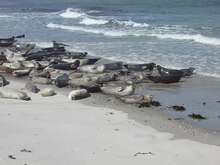seal
| seal | ||||||||||||
|---|---|---|---|---|---|---|---|---|---|---|---|---|

seal |
||||||||||||
| Systematics | ||||||||||||
|
||||||||||||
| Scientific name | ||||||||||||
| Phoca vitulina | ||||||||||||
| Linnaeus , 1758 |
The harbor seal ( Phoca vitulina ) is a seal from the dog seal family that is common in all northern temperate seas .
Appearance

Seals are, in comparison to the other common seal on German coasts, the gray seal , small and slender seals (males around 170 cm, females 140 cm, weight 150 and 100 kg, respectively). They also differ from the gray seal in their rounded head. The color is regionally very variable; In German coastal waters, seals are dark gray in color and have black spots that are irregularly distributed over their bodies.
distribution and habitat
The seal is found in the northern hemisphere in the Atlantic and Pacific . It prefers coastlines with dry sandbanks. But you can also find it on protected rocky coasts.
The total global population of seals is estimated at 500,000 individuals. 90,000 of these live on European coasts.
While the seal is widespread along the entire North Sea coast , it is extremely rare in the Baltic Sea ; the population in this inland sea is estimated at 250 animals, which makes common seals in the Baltic Sea even rarer than cone and ringed seals . The Baltic seals live on the coasts of Danish islands and southern Sweden . Migrating young seals sometimes also come to German Baltic coasts.
Way of life

Seals are very good swimmers and can dive up to 200 meters for 30 minutes. Usually a dive lasts only three minutes. Adult seals eat only fish, namely herrings , sardines , cod , salmon , smelt and flatfish . Younger seals feed largely on other marine animals such as crustaceans and molluscs . Seals are solitary in the water; they often come together in small groups on sandbanks. However, they are not social animals and react aggressively to contact by other species; especially males occasionally inflict bloody wounds on each other. On the sandbanks they are therefore usually evenly distributed, with a minimum distance of one and a half meters between two animals.
From July to the beginning of September, mating takes place in the water. Several males gather around a female and try to get on her back. The female initially defends herself against mating with bites and attempts to escape. Ultimately, one of the males wins by immobilizing the female with a bite on the neck. After about three minutes, the act of mating is over and both partners swim their way. Male seals are neither monogamous nor do they guard harem like some other seals.
The gestation period is then 11 months, with embryonic growth being suspended for the first two to two and a half months. The litter time is again in the months of June and July in the following year. As a rule, only one young animal is born that weighs around 10 kg at birth, is 85 cm long and fully buoyant. It is suckled for about five weeks and then left alone.
Seals in the wild live to be around 20 to 35 years old, while females usually have a longer life expectancy than males, who exhaust themselves in fights with their peers and rarely reach an older age than 25 years. The oldest seal kept in a zoo died at the age of 53.
Not every seal on the beach is a "howler". Individual seals lie on the beaches and rest again and again. A typical sign of relaxation is the "banana position". The head and the back are then in the air and the distinctive banana curve can be seen.
Subspecies
There are five geographical subspecies:
- European seal ( Phoca vitulina vitulina ), European coasts including Iceland
- Phoca vitulina concolor , east coast of North America from the Arctic Ocean to Maine
- Phoca vitulina richardsi , west coast of North America from Alaska to Baja California
- Kuril sea dog ( Phoca vitulina stejnegeri ), coastal Hokkaidōs , the Kuril Islands and Kamchatkas
- Ungava seal ( Phoca vitulina mellonae ), lakes in northern Québec , Canada (only seal living in freshwater)
The largha seal was previously classified as a subspecies of the seal, but is now classified as a separate species.
Man and seal
etymology
The term “seal” originally had nothing to do with the sea or with dogs, but is a folk etymological reinterpretation of a Germanic word (common Germanic * selha , ahd. Sēlah (o) , mhd. Seleh , sel ) which simply means “seal” and has been preserved in the English seal and the Swedish säl . Even in Early New High German there are occasionally forms with l like Seel and Seelhund . The further derivation is uncertain, the word probably goes back to the Indo-European root * selk- "pull, drag"; but it may also be a borrowing from a Baltic Finnish language (cf. Finnish hylje ).
Seal hunting in prehistoric times and the Middle Ages
For thousands of years, seals have been hunted by inhabitants of the coasts for food, fur and oil . Ten stone slabs have been discovered along the Lower Rhine, on which Ice Age settlers engraved the outlines of seals - although it is not always clear whether the animals depicted are seals or the gray seals that were once just as common . Other seal species, which are now restricted to the Arctic , also lived on European coasts during the last Ice Age. Seals swam again and again up the rivers and got into the nets of inland fishermen themselves. Even today seals occasionally swim up the Rhine , Weser and Elbe rivers, but do not get as far as they once did.
On the Danish coasts it was found at 7,500 BC. Wooden clubs, which were preserved under a layer of peat, dated to the 4th century BC. Since seals were beaten with similar clubs on the North Sea coasts up to the 19th century, it is assumed that the hunters of the Neolithic period pursued this activity. Arrowheads have also been found in seal bones. However, only a few remains of seals come from this period. At that time, gray seals , ringed seals and harp seals inhabited the North and Baltic Seas in large numbers, and it wasn't until the turn of the century that the harbor seal became common here. Seal bones from the 1st century can be found along the Weser estuary, which were stored in the garbage pits of the terp inhabitants together with pet bones . Similar finds come from the early Middle Ages on the island of Föhr . In the centuries that followed, seal hunting became increasingly uncommon. After the 11th century, seal bones are the exception in human settlements.
Extinction campaigns of the 19th and 20th centuries
It was not until the late 19th century that seals began to be hunted for other reasons: the beginning of industrial fishing and the looming overfishing of the seas led fishermen to believe that the seal, as a food competitor, plundered the fish stocks. The extinction of the seal was seen as a worthwhile goal. In 1902, the fishermen from Rügen complained in a joint petition to the Stralsund administrative district that they were "undoubtedly heading towards ruin" without "exterminating the seals". For each seal hunted, 5 marks were paid in Western Pomerania, and other Baltic states soon followed suit and also paid bonuses. The animals were shot, killed and caught with nets and fish traps; Laying out poisoned fishing bait has also been used as a method in some regions. Between 1886 and 1927, 353,329 seals were killed in the Baltic Sea, bringing both the harbor seal and the gray seal to the verge of complete extinction.
In the North Sea , too , seals were hunted by premium hunters. The greater expanse of the North Sea made such an effective extermination as in the Baltic Sea more difficult - especially since the stock was supplemented from the Atlantic. But from the 1930s it became apparent that seals were becoming rarer. In 1953, unregulated hunting was ended in the Federal Hunting Act. From then on, an interested party had to apply to the hunting authority in his district for a permit that gave him the right to hunt seals. For about 250 marks you could have a guide bring you to a seal and kill it. Populations collapsed in the 1960s and the seal became a rarity. The Netherlands banned hunting in 1962, Lower Saxony followed in 1971, Schleswig-Holstein in 1973 and Denmark in 1977 . Since poaching is rare these days , seals hardly ever die from being shot in the North Sea. Since the hunt was stopped, the stocks have recovered from a threatening low. There are an estimated 7,000 seals in the Schleswig-Holstein Wadden Sea National Park .
Environmental toxins
Even after the seal hunt ended, large numbers of seals continued to die from non-natural causes. Environmental toxins such as PCB made their way into the North and Baltic Seas until the 1980s. They weakened the seals and made them sterile; In the Baltic Sea, where exposure was particularly problematic, seals examined showed uterine occlusions, tumors, kidney damage, intestinal ulcers and skin changes. Due to a weakened immune system, the oral cavities were covered with fungus.
The PDV epidemic
How sensitive the population still is was shown by an epidemic in 1988, which was a variety of canine distemper , the PD virus ( phocine distemper virus ). 18,000 seals, two thirds of the total population, died from it. The extent of the disease was probably due to the general immune deficiency of the North Sea seals. In regions less affected by pollutant discharges, such as the Norwegian and Icelandic coasts, the epidemic has claimed almost no victims among the seals. The epidemic was repeated, albeit on a less catastrophic scale, in 2002, and in 2007 animals were also found in Denmark and Sweden that were infected with a similar epidemic.
The origin of the PDV was initially unclear. The discovery in 1988 that minks were also infected with PDV caused a stir . The theory has been expressed that mink runaway from farms infected the seals. However, the route of infection was probably reversed. Then in the 1990s it was found that harp seals carry the PDV virus but do not get it. As individual harp seals got lost in the North Sea in the harsh winter of 1987, this may have been the way the epidemic reached the Wadden Sea. It was said from fishing circles that the disease would reduce the population to a natural level.
Howler Rearing
Young animals that have finally lost their mother and have not been suckled for days are called howlers because of their vocalizations . In recent times, attempts have been made to save the abandoned animals. The first successful rearing of a howler became known in 1956; however, the animal was then taken to the Wilhelmshaven Aquarium and not released into the wild, as the seal hunt was common at the time, and the survival of a man-raised seal was considered very unlikely. Permanent seal rearing stations have been set up along the North Sea coast since the 1970s .
Howlers are a natural phenomenon. They have lost their mother to abandonment, death or storms, or the mother has abandoned a sick or injured young animal. The purpose of seal rearing stations has been the subject of controversy. On the one hand, healthy seal pups were brought there, whose mother was looking for food and would have returned to her boy - estimates by the critics even assume that this applies to 90% of all howlers brought in. Seals that are really sick and in need of care, on the other hand, have been singled out through natural selection, and it is unnatural to nurse them up and help them to live in freedom. In the hatcheries there are deaths from stress or from force-feeding, which is necessary as the howlers almost always refuse to eat. The seals that are ultimately released are often semi-tame and avoid their conspecifics.
The criticism has led to Denmark not releasing howlers into the wild since 1985 and all howlers found have been killed since 1993. There was also a rethink on the German North Sea coasts. The station in Friedrichskoog no longer accepts sick or injured howlers. Many seal banks are now located in the core zones of the national parks, so that tourists can no longer pick up howlers. The seals brought to Friedrichskoog are released back into the wild, with the exception of individual cases.
Hazardous situation and protective measures
The global population of the seal is listed by the International Union for Conservation of Nature IUCN in the Red List of Endangered Species as Least Concern (not endangered). The Federal Republic of Germany places this seal species in category 3 (“endangered”) on the national red list. In another five countries in the Federal Republic of Germany, this species has been placed on the red list of the respective country, some with different endangerment categories.
The seal is placed under protection by listing in Appendix III of the Bern Convention of the Council of Europe of November 19, 1979, whereby its use is only permitted and regulated in exceptional cases.
The European Union also adopts this stance. Like all species of the dog seal family, it lists this species in the Fauna-Flora-Habitat Directive No. 92/43 / EEC, Appendix V as a wild animal to be strictly protected with the possibility of use; In addition, it is also listed in Appendix II, which means that the establishment of protected areas is mandatory.
In 1991 the Agreement on the Conservation of Seals in the Wadden Sea , signed by Denmark, Germany and the Netherlands, came into force.
In Germany it is forbidden to take seals from nature. The violation is an administrative offense and can be subject to a fine of up to 10,000.00 in accordance with the BNatSchG (Section 69 (3) No. 10 in conjunction with Section 39 (2) sentence 1 and Annex V of Directive 92/43 / EEC). Euro are punished (§ 69 Abs. 6 BNatSchG). It is also forbidden to take possession of them, to process them or to use them in any other way, to sell them, to offer them, to sell them or to bring them into circulation in any other way, as well as to transport them for the purposes mentioned (§§ 2 Para in conjunction with Section 1 of Annex 1 of the BWildSchVO). The violation of these prohibitions is an administrative offense and can be punished with a fine of up to 5000, - Euro (§ 39 Abs. 2 Nr. 5 BJagdG in conjunction with § 6 Abs. 1 Nr. 1 BWildSchVO).
The seal was proclaimed "Wild Animal of the Year 2006" by the German Wildlife Protection Association .
literature
- Ronald M. Nowak: Walker's Mammals of the World . 6th edition. Johns Hopkins University Press, Baltimore 1999, ISBN 0-8018-5789-9 (English).
- Bernhard Grzimek: Grzimeks Tierleben , Volume 12 (Mammals 3), ISBN 3-8289-1603-1
- Armin Maywald: The world of seals: a portrait between fascination and threatened nature . Soltau-Kurier-Norden, 2002, ISBN 3-928327-60-7
- Rüdiger Wandrey: The whales and seals of the world: occurrence, endangerment, protection . Franckh-Kosmos, 1997, ISBN 3-440-07047-6
- Heiderose & Andreas Fischer-Nagel: Seals in the Wadden Sea . Verlag Fischer-Nagel, 2013, ISBN 978-3-930038-33-6
Web links
- Phoca vitulina in the endangered Red List species the IUCN 2009. Posted by: Thompson, D. & Härkönen, T. (IUCN SSC Pinniped Specialist Group), 2008. Accessed January 17 of 2010.
- seehund.de - The seal portal
- Dealing with howls in the North Frisian Wadden Sea
- Seal photos from the natural habitat of the North Sea.
- Seal station Friedrichskoog eV - information, rearing, research
- Seal rearing and research station Norddeich
Individual evidence
- ↑ The oldest zoo seal in the world is dead. Rheinische Post, accessed on August 26, 2019 .
- ↑ Howler. July 25, 2010, accessed March 27, 2020 .
- ↑ Wolfgang Pfeifer (Ed.): Etymological Dictionary of German . 2nd Edition. Akademie-Verlag, Berlin 1992, sv Seehund (online in the context of the digital dictionary of the German language of the 20th century ); see also: WJJ Pijnenburg: De etymologie van mnl. zale 'zeehond' . In: Naamkunde 17, 1985. pp. 284-291; F. de Tollenaere: Van zee-, zeel- en zaalhonden . In: Tijdschrift voor Nederlandse Taal en Letterkunde 106, pp. 249-259.
- ↑ Ovanligt virus in Dagens Nyheter (Swedish)
- ↑ Red List of Endangered Animals in Germany. (PDF 429.39 KB) (No longer available online.) In: Binot & al. 1998 register. German Federal Agency for Nature Conservation, archived from the original on March 1, 2016 ; Retrieved January 17, 2010 . Info: The archive link was inserted automatically and has not yet been checked. Please check the original and archive link according to the instructions and then remove this notice.
- ↑ Query of the seal in the Red List of Endangered Animals in Germany. science4you, accessed February 4, 2010 .
- ↑ Bern Convention. Council of Europe, accessed January 17, 2010 (Appendix III).
- ↑ Directive 92/43 / EEC (Fauna-Flora-Habitat Directive) in the consolidated version of January 1, 2007 , accessed on January 17, 2010










